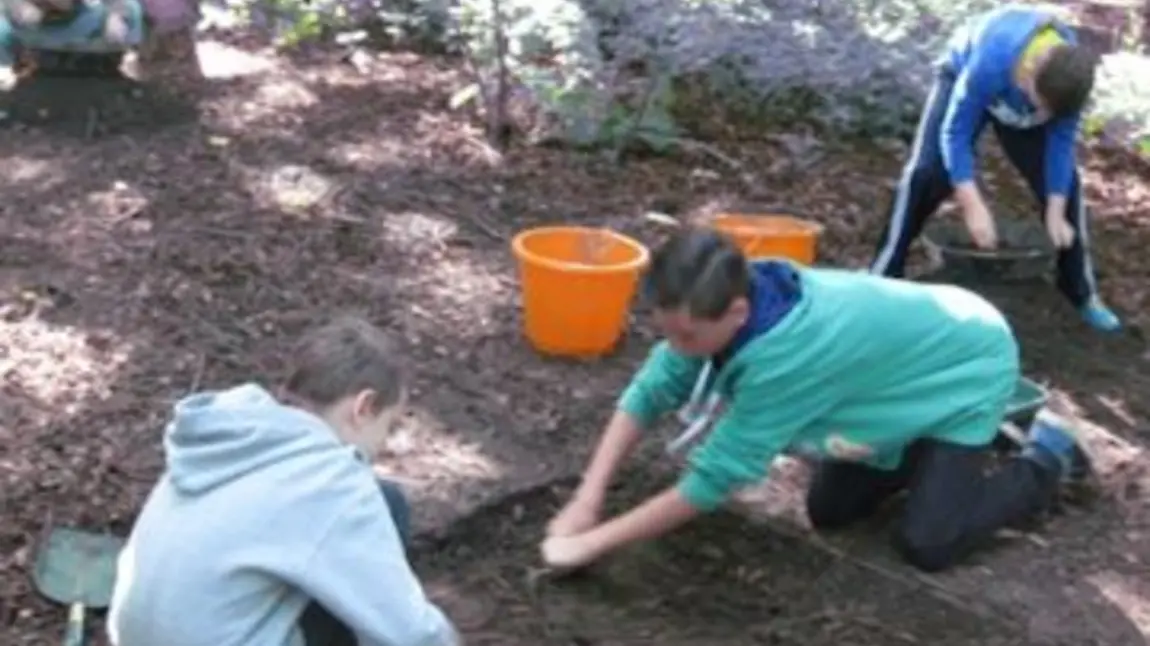Local schools preliminary Charting Chipeling dig

Children, aged 4–11, came from Bolton-on-Swale St. Mary’s Primary Church of England School, Brompton-on-Swale Church of England and North and South Cowton Community Primary schools to dig in the grounds of the Jacobean Hall with local Archaeologist, Jim Brightman, of Solstice Heritage.
Mr Brightman is leading the Charting Chipeling project, which has been facilitated by the Heritage Lottery Fund (HLF) through a grant to the Kiplin Hall Trust of £53,100. The project began last October when Mr Brightman was appointed and will culminate next year with an exhibition about the history of the area, how the research was conducted and, hopefully, some interesting finds.
The children were digging in test pits in a place identified by Mr Brightman as the possible site of an old road. Children worked in groups of three on 11 pits, and one group were very excited to find the packed surface of the road, which ran north to south through the estate before the current road was created in the late 18th century. Further investigations into the find will take place during the summer when a full archaeological dig will take place in various parts of the Estate, which have been identified as being of interest through walk over surveys, the study of old maps and photographic evidence. Pottery and prehistoric stone tools found in the test pits have been taken away for further examination.
The archaeological project now has a dedicated website which records the history of the area around Kiplin Hall and gives details about progress of the investigations, which include a laser scan of the Hall, research into the Kiplin Hall archive and drawing and photographing areas of interest.
Notes to editors
Kiplin Hall was built in the 1620s by George Calvert, Secretary of State to James I and founder of Maryland. The house and gardens are open to the public Sunday – Wednesday until the end of October. The gardens and tea room from 10am and the house from 2pm; all close at 5pm. The award-winning attraction is between Richmond and Northallerton on the B6271 Scorton to Northallerton road, about 5 miles east of the A1. Post code DL10 6AT.
The landscape around the Kiplin Estate is rich in prehistoric and Roman archaeological sites, especially given the proximity of Cataractonium (Roman Catterick). The wide sand and gravel terraces flanking the nearby River Swale are known to host archaeological remains from the Mesolithic period, some 12,000 years ago. Catterick, across the river, was prominent during the Anglo-Saxon period, one of the principal settlements of the Kingdom of Deira, and later, Northumbria, and the Anglo Saxon Chronicle places the mass baptism of pagans by St. Paulinus in the River Swale near Kiplin in the early 7th century AD. The parish of Kiplin was already a settlement by the time of the Norman Conquest – it is the 11th century name of Chipeling which is commemorated in the title of this project. Until the Dissolution of the Monasteries in the 16th century, Kiplin’s grounds were part of the Easby Abbey Estate, and prior to the building of the Hall, an older house stood nearby.
Further information
Kiplin Hall: Dawn Webster, Curator or Marcia McLuckie, Administrator on 01748 818 178 or 07740 927 608.